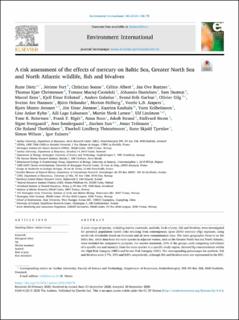| dc.contributor.author | Dietz, Rune | |
| dc.contributor.author | Fort, Jérôme | |
| dc.contributor.author | Sonne, Christian | |
| dc.contributor.author | Albert, Céline | |
| dc.contributor.author | Bustnes, Jan Ove | |
| dc.contributor.author | Christensen, Thomas Kjær | |
| dc.contributor.author | Ciesielski, Tomasz Maciej | |
| dc.contributor.author | Danielsen, Jóhannis | |
| dc.contributor.author | Dastnai, Sam | |
| dc.contributor.author | Eens, Marcel | |
| dc.contributor.author | Erikstad, Kjell E | |
| dc.contributor.author | Galatius, Anders | |
| dc.contributor.author | Garbus, Svend-Erik | |
| dc.contributor.author | Gilg, Oliver | |
| dc.contributor.author | Hanssen, Sveinn Are | |
| dc.contributor.author | Helander, Björn | |
| dc.contributor.author | Helberg, Morten | |
| dc.contributor.author | Jaspers, Veerle | |
| dc.contributor.author | Jenssen, Bjørn Munro | |
| dc.contributor.author | Jónsson, Jón Einar | |
| dc.contributor.author | Kauhala, Kaarina | |
| dc.contributor.author | Kolbeinsson, Yann | |
| dc.contributor.author | Kyhn, Line A. | |
| dc.contributor.author | Labansen, Aili Lage | |
| dc.contributor.author | Larsen, Martin M. | |
| dc.contributor.author | Lindstrøm, Ulf | |
| dc.contributor.author | Reiertsen, Tone Kristin | |
| dc.contributor.author | Rigét, Frank F. | |
| dc.contributor.author | Roos, Anna | |
| dc.contributor.author | Strand, Jakob | |
| dc.contributor.author | Strøm, Hallvard | |
| dc.contributor.author | Søndergaard, Jens | |
| dc.contributor.author | Sun, Jiachen | |
| dc.contributor.author | Teilmann, Jonas | |
| dc.contributor.author | Therkildsen, Ole Roland | |
| dc.contributor.author | Thórarinsson, Thorkell Lindberg | |
| dc.contributor.author | Tjørnløv, Rune Skjold | |
| dc.contributor.author | Wilson, Simon | |
| dc.contributor.author | Eulaers, Igor | |
| dc.date.accessioned | 2020-12-02T08:53:37Z | |
| dc.date.available | 2020-12-02T08:53:37Z | |
| dc.date.created | 2020-11-26T09:37:12Z | |
| dc.date.issued | 2020 | |
| dc.identifier.issn | 0160-4120 | |
| dc.identifier.uri | https://hdl.handle.net/11250/2711340 | |
| dc.description.abstract | A wide range of species, including marine mammals, seabirds, birds of prey, fish and bivalves, were investigated for potential population health risks resulting from contemporary (post 2000) mercury (Hg) exposure, using novel risk thresholds based on literature and de novo contamination data. The main geographic focus is on the Baltic Sea, while data from the same species in adjacent waters, such as the Greater North Sea and North Atlantic, were included for comparative purposes. For marine mammals, 23% of the groups, each composing individuals of a specific sex and maturity from the same species in a specific study region, showed Hg-concentrations within the High Risk Category (HRC) and Severe Risk Category (SRC). The corresponding percentages for seabirds, fish and bivalves were 2.7%, 25% and 8.0%, respectively, although fish and bivalves were not represented in the SRC. | en_US |
| dc.language.iso | eng | en_US |
| dc.publisher | Elsevier | en_US |
| dc.rights | Navngivelse 4.0 Internasjonal | * |
| dc.rights.uri | http://creativecommons.org/licenses/by/4.0/deed.no | * |
| dc.title | A risk assessment of the effects of mercury on Baltic Sea, Greater North Sea and North Atlantic wildlife, fish and bivalves | en_US |
| dc.type | Peer reviewed | en_US |
| dc.type | Journal article | en_US |
| dc.description.version | publishedVersion | en_US |
| dc.source.journal | Environment International | en_US |
| dc.identifier.doi | 10.1016/j.envint.2020.106178 | |
| dc.identifier.cristin | 1852642 | |
| dc.description.localcode | © 2020 The Authors. Published by Elsevier Ltd. This is an open access article under the CC BY license (http://creativecommons.org/licenses/by/4.0/). | en_US |
| cristin.ispublished | true | |
| cristin.fulltext | original | |
| cristin.qualitycode | 1 | |

